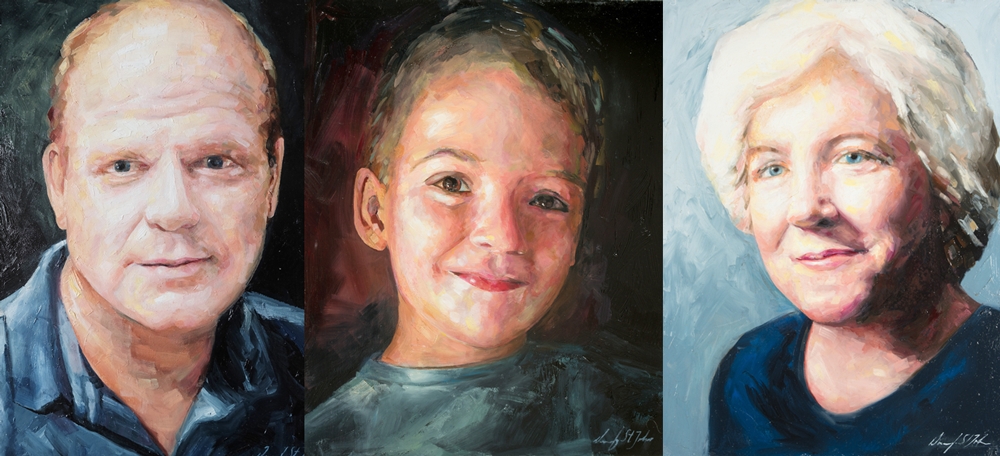The personal stories of trauma, illness and loss behind the seven portraits that Donna F. St. John painted for Moving Through the Unimaginable encompass a more painful past than the seemingly jovial faces let on.
Although a small part of the exhibition, the portraits put a face to the collective human experience of moving through adversity and coming out stronger, wiser and more resilient. This special spring exhibition at Saugatuck Center for the Arts celebrates the strength of the human spirit and triumph over tribulation through storytelling and a variety of artistic outlets.
Organizers invited community members to anonymously submit stories of their hardship and pain, and how they overcame life’s adversities to find hope, peace and wholeness.
“That’s the first part of healing, being able to reflect on what happened and putting it on paper,” St. John said. “That act alone has been a really beautiful piece of healing for several of people who have submitted. They’ve actually said, ‘Thank you for listening to my story.’”
The stories were incorporated into a sandbag installation, along with being assembled into a book and auditory pieces that play in the gallery. Visitors can continue to submit their stories throughout the run of the exhibit.
The installation features sandbags suspended from the ceiling, with a selection of stories silkscreened onto burlap fabric and the word “release” hand-stitched over them. Every few days, SCA staff will cut a small slit in some of the bags so the sand can slowly pour out on the silver floor below — symbolic of letting go of the pain and moving forward.
“They should all be emptied, and part of the installation process will be to sweep all of that sand together so all the stories are intersecting,” said Whitney Valentine, SCA’s education and exhibitions manager. “The sand is symbolic of our life story.”
“At the end, all of these stories will be released to represent the healing process,” St. John added.
St. John, a professor at Kendall College of Art and Design, also made several assemblage sculptures, based on her interviews and the submissions, that represent what helped people come through the adversity.
A mix of stories all typed in different fonts were printed, laser cut, framed and hung up throughout the gallery. The stories speak of healing from losing a loved one and divorce, surviving cancer and infertility, depression and mental illness, sexual abuse and incarceration, addiction and eating disorders, bullying and LGBTQ issues.
“The beauty of that — you can immediately see that there is an intersection, there is an overlap of so many of these stories,” St. John said. “As dark as things were, so many of them had a sense of hope that things would get better.”
St. John worked with Valentine to plan and organize the exhibition. They began soliciting the stories last summer and offering art classes and workshops with community program partners.
“We really do have high hopes that it can transform lives,” Valentine said. “We’ve been shocked, and really hopeful, that we’ve gotten so many responses. We know that writing these is not easy. It’s really tough, and people have taken the time to self-reflect and release those emotions.”
They led four-week art therapy classes that included reflective writing and drawing instruction, working with female inmates at Allegan County Corrections Center and teens at Children’s Advocacy Center. The exhibition includes their framed charcoal drawings of songbirds and some written stories.
Through the interviews for the portraits and other outreach classes, St. John was moved by the resilience, courage and optimism they expressed despite life’s challenges. Several people talked about what helped them through, from talk therapy to movement, art, faith and looking at family history and seeing patterns.
The individuals selected for the portraits are a diverse mix of community members with inspiring stories, and they will receive their portraits after the exhibition ends.
St. John’s biggest takeaway: Whatever people go through, the emotions behind the adversity are the same. With compassion and kindness, people from seemingly different walks of life can unite in the shared human experience of suffering and ultimately healing.
“The greatest beauty of the exhibition is not only the collection of these stories, but allowing the viewer to slow down the trajectory of these stories and recognize the overlap, and that’s where I think we find empathy and wisdom,” St. John said. “We all feel sadness, we all feel fear. It takes away the us-them mentality.”
Valentine hopes visiting the exhibit inspires more people to submit their stories, and that the SCA will have hundreds of more stories to compile into a traveling exhibition or book when the exhibition closes in May.
Moving Through the Unimaginable
Saugatuck Center for the Arts
400 Culver St., Saugatuck
March 16-May 26
sc4a.org, (269) 857-2399





